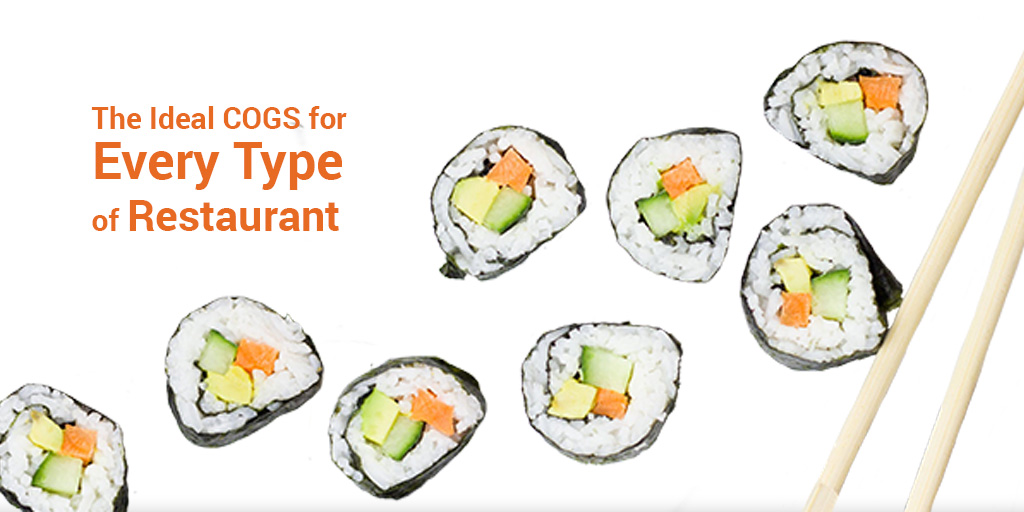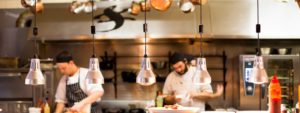You know finding your ideal COGS (cost of goods sold) is vital.
It’s the secret sauce in your restaurant’s recipe for success.
But lately, we’ve realized our constant advice on lowering your food costs and managing your COGS isn’t as specific it needs to be.
Speaking in general terms isn’t always good enough.
You need to know what’s good for your restaurant.
After all, no two establishments are exactly the same. And neither are their routes to profitability.
They all have their own specific demands and considerations to take into account.
Food Costs can range anywhere from low 20s to high thirties, with an average range of 28-32%.
So, we’ve got lowdown on how to take a restaurant that’s seeping in the red and burst it into the green – all by helping you understand the ideal COGS for your specific restaurant.
Because, at the end of the day, we know managing your restaurant’s costs and cash flow is far from simple.
But we’re here to make it easier.
Download the full guide here, or read it below.
Restaurant Type 1: Fine Dining
In general, fine dining restaurants are going to have higher COGS than most other restaurant types. The ideal range is in the mid-to-low 30s.
Why is the Ideal COGS in this range?
Most obviously, the actual food purchased costs more. If you’re running a fancy white tablecloth establishment, you won’t be buying the same ingredients as that local diner across town.
You’ll have nicer cuts of steak, farm-to-table produce, and top-of-the-line ingredients.
Does this mean your restaurant will be more or less profitable?
Not at all.
There are many ways you can make up for higher food costs.
For starters, you’re going to be able to charge a whole lot more for that delicious cut of meat than a local diner would charge for their standard burger and crinkle-cut fries.
So though you paid more for it, you’ll make more, too.
Also, diners at your restaurant are enjoying a nice night out – and are much more likely to sip from one of the wine bottles adorning your shelves or a craft cocktail from your bar.
As long as you’re managing your bar the right way, this will keep the cash pouring in.
Plus, in fine dining, your labor costs can be a bit lower – it takes skill to cook a steak, but not necessarily a lot of time.
But if you find and leverage the profit-boosting and cost-cutting opportunities in your restaurant, you’ll reap the rewards.
Any tips or tricks?
- If you’re running a fine dining restaurant that’s committed to fresh, locally-sourced produce, make sure you constantly stay on top of market prices. This way, you’ll never pay a premium to your suppliers.
Restaurant Type 2 – Bakeries
Generally speaking, bakeries should – and tend to – have the lowest COGS. It’s usually around the low 20s, but sometimes even as low as the mid-to-high teens.
Why is the Ideal COGS in this range?
Unlike other restaurants, the majority of the ingredients bakeries routinely order are fairly cheap. Large, inexpensive orders of non-perishable items mean low costs.
It takes a bit more for flour, chocolate, and sugar to break the bank.
Does this mean your restaurant will be more or less profitable?
Low food costs may sound more delicious than icing on a freshly baked cinnamon roll.
But in the restaurant world, there’s no guarantee it means your restaurant will be profitable.
In a bakery, you’re selling your pastries, cakes, and coffees at a lower price than a steakhouse would sell its food.
Also, since you’re buying ingredients in bulk, any large change in an ingredients’ market price could have a large impact on your margins. Especially if you’re not paying attention.
On top of that, your bakery will typically have relatively higher labor costs – thanks to the skill, precision, and time involved in preparing those delectable baked goods in your display.
Without a doubt, though, the biggest obstacle your bakery will have to deal with is food waste.
Sure, those sweet ingredients you bought on the cheap have a long shelf-life, but it’s rare for bakeries to keep foods for any longer than a day or so.
It’s not like you’re making things to order, after all.
And if you don’t prepare correctly, you can expect a large amount of those cranberry scones, apple pies, and strawberry shortcakes to be tossed in the bin at day’s end.
And wasted food equals wasted cash.
Any tips or tricks?
- The key to minimizing wasted food and cash is to be aware of the market prices of ingredients, and to always make smart, informed purchasing decisions about your inventory turnover rate.
- If you’re adding a specialty treat to your display, make sure it’s not costing your restaurant an arm and a leg to make it. And make sure people actually want to eat it.
- Don’t overbuy ingredients ahead of time. Not every new recipe is going to become the next Cronut.
- If you’re regularly throwing an ingredient in the trash, or if one of your menu items isn’t selling, adjust your orders to reflect those facts.
Restaurant Type 3 – Pizzerias
Pizzerias should have relatively low COGS. A solid goal is in the mid-20s.
Why is the Ideal COGS in this range?
Similarly to bakeries, pizza ingredients are cheaper. However, there are more fresh ingredients tossed in the mix.
Mozzarella, veggies, and meats – they’re going to raise your COGS, and they need to be managed.
Does this mean your restaurant will be more or less profitable?
Again, context matters.
If you play your cards right and smartly manage your food costs, the cash will fly in.
Lowering food costs, in large part, comes down to consistently monitoring ingredient market prices.
If you’re blindly purchasing pepperoni weekly, you’ll most likely end up paying more by the pound each week.
And that’s just ridiculous.
As for labor costs in a pizza joint, they are relatively low compared to more upscale restaurants.
Sure, pizzas take care and attention to detail to create, but they can also be churned out quickly.
Any tips or tricks?
- Adding non-pizza food – like wings or a delicious dessert – can help when it comes to up charging a meal.
- But before you decide to add a special menu item, plan carefully and monitor to determine if it’s successful or not and if you can afford it.
Restaurant Type 4 – Mexican, Chinese, Italian, and Other Food From Around the World
While we don’t have a specific COGS for each type of these restaurants, all buy similar types of ingredients and tend to fall in similar ranges.
If you run one of these restaurants, aim for a COGS in the high 20s – and alter it depending on the style, type of food, and menu offerings.
We know this category ranges, so the COGS numbers will as well.
A taco truck dishing out Mexican street food is going to have a very different COGS than a Mexico City-inspired sit-down restaurant selling ceviche and thoughtful tequila-infused cocktails.
Why is the Ideal COGS in this range?
These types of restaurants rely heavily on inexpensive ingredients like rice, noodles, and pasta – which aren’t going to affect your overhead much.
On the other hand, they also often require special types of produce, spices, sauces, and imported goods that may only be available from a few suppliers.
A low supply means higher prices, so it’s important to ensure you’re not being taken advantage of.
Does this mean your restaurant will be more or less profitable?
Again, this only has some bearing on whether your restaurant will be profitable or not. It’s not the end all, be all.
It boils down to how smart you are about running your business.
For example, if you’re running a Korean restaurant and need a type of hard-to-get ponytail radish, don’t buy any more than you need.
You definitely don’t want any expensive ingredients rotting away on your shelves.
Any tips or tricks?
- Just because you need a tough-to-find ingredient doesn’t mean your suppliers should be able to take advantage of you.
- Do your homework – find out if another food supplier pricing matches up better with your expectations.
Other Types of Restaurants
- Burger bars and BBQ joints
- Depending on the style, these restaurants should have COGS in the high 20s or low 30s
- If you’re grilling up specialty burgers with unique toppings and high-quality meat, expect to be at the higher end of that range. The same is true for BBQ restaurants using expensive cuts of meat.
- These types of restaurants are buying a lot more meat, which is more expensive, meaning your food costs will be a bit higher.
- These restaurants offer a great opportunity to boost profits by selling beer and liquor. Who doesn’t like a cold one with their burger or pulled pork sandwich?
- Bistros and Cafés
- Your COGS will depend heavily on the specific food and drinks you have on your menu.
- If you’re offering simple sandwiches and pastries, you’ll have significantly lower overhead.
- If your restaurant’s calling card is more complex concoctions using specialty or locally-sourced ingredients, expect it to be on the high end of the COGS spectrum.
Conclusion: Know Your Ideal COGS Like the Inside of Your Restaurant’s Kitchen
Whether you’re running a vegan cafe, a five-star steakhouse, or a fast-casual burrito chain, knowing what your ideal COGS should be is vital to your restaurant’s long-term profitability.
But now that you know what your COGS should look like, it’s time to take actionable steps to get it there.
And boost your restaurant’s profitability in the process.
Managing your COGS on your own will undoubtedly be a long and mistake-ridden process.
And we know you don’t want any more headaches to deal with at work.
But good news…
Restaurant technology can streamline the entire process for you.
Orderly puts managing and keeping up with your COGS on autopilot.
No more endless hours spent counting.
Just snap your invoices and they’ll go right into your digital file cabinet.
They get added to our expansive RFI. And you’ll be able to quickly see ingredient costs by supplier, pack size, and product – and be able to compare market prices as well.
When you upload your sales as well, your COGS will be calculated for you.
That’s less math and more money.
Less fudged numbers, and more time for everything else.
It’s the accurate, ideal COGS you need…
And a whole lot less stress.
What are you waiting for?





